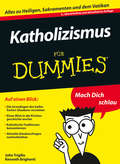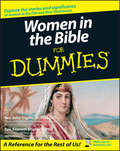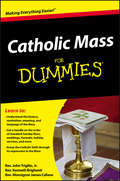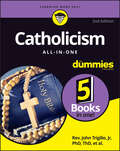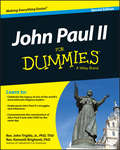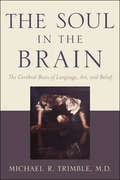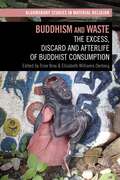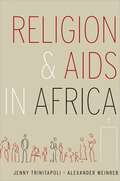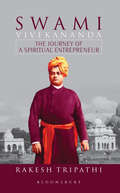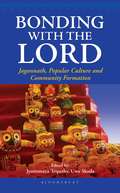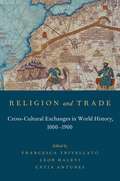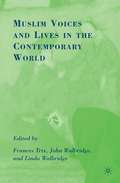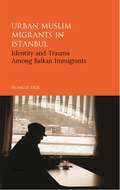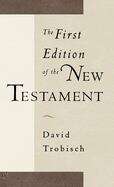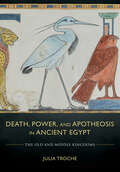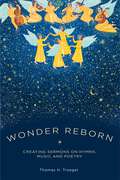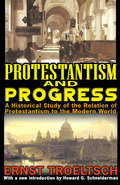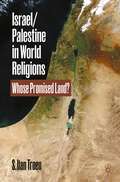- Table View
- List View
Katholizismus für Dummies (Für Dummies)
by Rev. John Trigilio Jr. Rev. Kenneth BrighentiJeder kennt sie, fast jeder hat sich eine Meinung über sie gebildet, aber kaum jemand weiß, wofür sie genau eintritt, was sie genau vermitteln will. Die Rede ist von der katholischen Kirche. »Katholizismus für Dummies« erklärt, wie und warum Katholiken Heilige verehren, was die Sakramente sind, welche Regeln für Katholiken gelten und wie die Kirche aufgebaut ist. Die Leser erfahren, wo die Unterschiede zwischen Katholiken und Protestanten liegen und was die römische Kirche so einzigartig macht. Das Buch ist dabei leicht verständlich und wird trotzdem der jahrhundertelang gereiften Theologie der römisch-katholischen Kirche gerecht.
Women in the Bible For Dummies
by Rev. John Trigilio Jr. Rev. Kenneth BrighentiComprehensive interfaith coverage of the important female figures This friendly, approachable guide introduces readers to the famous and infamous women of Scripture, describing in everyday language the contributions these women made in their time and ours. From Eve, Sarah, and Esther to Mary and Mary Magdalene, it discusses well-known women of both the Old and New Testaments, examining their role in Biblical narratives, their place in the Jewish and Christian faiths, and the lessons their stories impart to women today.
Catholic Mass For Dummies
by Rev. John Trigilio Jr. Rev. Kenneth Brighenti Rev. Monsignor James CafoneAn unintimidating guide to understanding the Catholic Mass Throughout the centuries, the liturgy of the Church has taken a variety of regional and historical forms, but one thing has remained constant: the Mass has always been the central form of Catholic worship. Catholic Mass For Dummies gives you a step-by-step overview of the Catholic Mass, as well as a close look at the history and meaning of the Mass as a central form of Catholic worship. You'll find information on the order of a Mass and coverage of major Masses. Covers standard Sunday Mass, weddings, funerals, holiday services, and holy days of obligation Provides insight on the events, symbols, themes, history, and language of the Mass Translations of a Mass in Castilian and Latin American Spanish If you're a Catholic looking to enhance your knowledge of your faith, an adult studying to convert to Catholicism, a CCD instructor, or a non-Catholic who wants to understand the many nuances of the Catholic Mass, this hands-on, friendly guide has you covered.
Catholic Mass For Dummies
by Rev. John Trigilio Jr. Rev. Kenneth Brighenti Rev. Monsignor James CafoneAn unintimidating guide to understanding the Catholic Mass Throughout the centuries, the liturgy of the Church has taken a variety of regional and historical forms, but one thing has remained constant: the Mass has always been the central form of Catholic worship. Catholic Mass For Dummies gives you a step-by-step overview of the Catholic Mass, as well as a close look at the history and meaning of the Mass as a central form of Catholic worship. You'll find information on the order of a Mass and coverage of major Masses. Covers standard Sunday Mass, weddings, funerals, holiday services, and holy days of obligation Provides insight on the events, symbols, themes, history, and language of the Mass Translations of a Mass in Castilian and Latin American Spanish If you're a Catholic looking to enhance your knowledge of your faith, an adult studying to convert to Catholicism, a CCD instructor, or a non-Catholic who wants to understand the many nuances of the Catholic Mass, this hands-on, friendly guide has you covered.
Catholicism All-in-One For Dummies
by Rev. John Trigilio Jr. Rev. Kenneth Brighenti Rev. Monsignor James Cafone Rev. Jonathan Toborowsky Annie SullivanLet there be light—illuminating info about today’s Catholic church Catholicism All-in-One For Dummies offers a path toward understanding the beliefs of the Catholic church and how the church operates. Fully updated with information on newly canonized saints, updated teachings from Pope Francis, and how Catholic beliefs intersect with the modern world, this edition gets you up to date with the last 2000 or so years or Catholic history. With five minibooks in one, this friendly Dummies guide will answer your pressing questions. What do Catholics believe? What happens in Mass? Who are the saints? What is the role of the Pope? And other cool stuff you’ve been wanting to know about this Christianity denomination with over one billion members worldwide. Discover the core tenets of the Catholic religion Learn all about the papacy and get to know Pope Francis Get a primer on the Catholic saints, including those newly canonized Walk through the traditions of Mass and the seven sacramentsThis is an excellent resource for anyone who needs a clear guide to the practices and rules of the Catholic faith and wants a fascinating look into a prominent world religion.
Catholicism All-in-One For Dummies
by Rev. John Trigilio Jr. Rev. Kenneth Brighenti Rev. Monsignor James Cafone Rev. Jonathan Toborowsky Annie SullivanLet there be light—illuminating info about today’s Catholic church Catholicism All-in-One For Dummies offers a path toward understanding the beliefs of the Catholic church and how the church operates. Fully updated with information on newly canonized saints, updated teachings from Pope Francis, and how Catholic beliefs intersect with the modern world, this edition gets you up to date with the last 2000 or so years or Catholic history. With five minibooks in one, this friendly Dummies guide will answer your pressing questions. What do Catholics believe? What happens in Mass? Who are the saints? What is the role of the Pope? And other cool stuff you’ve been wanting to know about this Christianity denomination with over one billion members worldwide. Discover the core tenets of the Catholic religion Learn all about the papacy and get to know Pope Francis Get a primer on the Catholic saints, including those newly canonized Walk through the traditions of Mass and the seven sacramentsThis is an excellent resource for anyone who needs a clear guide to the practices and rules of the Catholic faith and wants a fascinating look into a prominent world religion.
John Paul II For Dummies, Special Edition
by Rev. John Trigilio Jr. Rev. Kenneth Brighenti Rev. Jonathan ToborowskyFind out how two extraordinary leaders changed religion and the world In April 2014, Pope Francis will jointly canonize two predecessors, John Paul II and John XXIII, in a move that recognizes the extraordinary accomplishments of these leaders of the Catholic faith. An estimated 1 million people filled St. Peter's Square and the surrounding streets for John Paul II's beatification, and the joint canonization will attract even more. With John Paul II For Dummies, Special Edition you can learn more about these admired religious leaders and join millions of devotees in celebrating their lives and legacies. You'll get an in-depth look at John Paul II's remarkable life and achievements and learn more about the beloved John XXIII in a bonus chapter. With this special edition e-book written in friendly, plain English, you'll discover how John Paul II's deep religious convictions affected world politics, history, and the Catholic faith. You'll be introduced to his influences, his personal struggles, the way he impacted the Church, and his methods for spreading his powerful message. Catholics and non-Catholics alike will find the stories of these holy men fascinating and inspiring. Introduces you to the lives and legacies of both John Paul II and John XXIII Presents you with the struggles, influences, and approaches to world politics of John Paul II, whose actions had a great impact on history Includes a bonus chapter that details the life of John XXIII, who will be canonized along with John Paul II in April 2014 Written in an engaging, accessible style and a great read for Catholics and non-Catholics alike John Paul II For Dummies, Special Edition is your guide to discovering the exemplary lives of two rare and extraordinary men who have influenced generations of people all over the world.
John Paul II For Dummies, Special Edition
by Rev. John Trigilio Jr. Rev. Kenneth Brighenti Rev. Jonathan ToborowskyFind out how two extraordinary leaders changed religion and the world In April 2014, Pope Francis will jointly canonize two predecessors, John Paul II and John XXIII, in a move that recognizes the extraordinary accomplishments of these leaders of the Catholic faith. An estimated 1 million people filled St. Peter's Square and the surrounding streets for John Paul II's beatification, and the joint canonization will attract even more. With John Paul II For Dummies, Special Edition you can learn more about these admired religious leaders and join millions of devotees in celebrating their lives and legacies. You'll get an in-depth look at John Paul II's remarkable life and achievements and learn more about the beloved John XXIII in a bonus chapter. With this special edition e-book written in friendly, plain English, you'll discover how John Paul II's deep religious convictions affected world politics, history, and the Catholic faith. You'll be introduced to his influences, his personal struggles, the way he impacted the Church, and his methods for spreading his powerful message. Catholics and non-Catholics alike will find the stories of these holy men fascinating and inspiring. Introduces you to the lives and legacies of both John Paul II and John XXIII Presents you with the struggles, influences, and approaches to world politics of John Paul II, whose actions had a great impact on history Includes a bonus chapter that details the life of John XXIII, who will be canonized along with John Paul II in April 2014 Written in an engaging, accessible style and a great read for Catholics and non-Catholics alike John Paul II For Dummies, Special Edition is your guide to discovering the exemplary lives of two rare and extraordinary men who have influenced generations of people all over the world.
The Soul in the Brain: The Cerebral Basis of Language, Art, and Belief
by Michael R. TrimbleIn this provocative study, Michael R. Trimble, M.D., tackles the interrelationship between brain function, language, art—especially music and poetry—and religion. By examining the breakdown of language in several neuropsychiatric disorders, he identifies brain circuits that are involved with metaphor, poetry, music, and religious experiences. Drawing on this body of evidence, Trimble argues that religious experiences and beliefs are explicable biologically and relate to brain function, especially of the nondominant hemisphere.Inspired by the writings and reflections of his patients—many of whom have epilepsy, psychosis, or affective disorders—Trimble asks how the human species, so enamored of its own logic and critical facilities, has held from the dawn of civilization strong religious beliefs and a reverence for the arts. He explores topics such as the phenomena of hypergraphia and hyper-religiosity, how religious experiences and poetic expression are neurologically linked with our capacity to respond to music, and how neuropsychiatric disorders influence behaviors related to artistic expression and religiosity by disturbing brain function.With the sensitivity of a dedicated doctor and the curiosity of an accomplished scholar, Trimble offers an insightful analysis of how the study of people with paradigmatical neuropsychiatric conditions can be the cornerstone to unraveling some of the mysteries of the cerebral representations of our highest cultural experiences.
Buddhism and Waste: The Excess, Discard, and Afterlife of Buddhist Consumption (Bloomsbury Studies in Material Religion)
by Trine Brox and Elizabeth Williams-OerbergIn what ways do Buddhists recognize, define, and sort waste from non-waste? What happens to Buddhist-related waste? How do new practices of Buddhist consumption result in new forms of waste and consequently new ways of dealing with waste? This book explores these questions in a close examination of a religion that is often portrayed as anti-materialist and non-economic. It provides insight into the complexity of Buddhist consumption, conceptions of waste, and waste care. Examples include scripture that has been torn and cannot be read, or an amulet that has disintegrated, as well as garbage left behind on a pilgrimage, or the offerings of food and prayer scarves that create ecological contamination. Chapters cover mass-production and over-consumption, the wastefulness of consumerism, the by-products of Buddhist practices like rituals and festivals, and the impact of increased Buddhist consumption on religious practices and social relations. The book also looks at waste in terms of what is discarded, exploring issues of when and why particular objects and practices are sorted and handled as sacred and disposable. Contributors address how sacred materiality is destined to wear and decay, as well as ideas about redistribution, regeneration or recycling, and the idea of waste as afterlife.
Religion and AIDS in Africa
by Jenny Trinitapoli Alexander WeinrebThe first comprehensive empirical account of how religion affects the interpretation, prevention, and mitigation of AIDS in Africa, the world's most religious continent.
Religion and AIDS in Africa
by Jenny Trinitapoli Alexander WeinrebThe first comprehensive empirical account of how religion affects the interpretation, prevention, and mitigation of AIDS in Africa, the world's most religious continent.
Swami Vivekananda: The Journey of a Spiritual Entrepreneur
by Rakesh TripathiSwami Vivekananda: The Journey of a Spiritual Entrepreneur details the events of Vivekananda's life, encompassing his transformation from a nameless wanderer to the most renowned representative of Hinduism of all times. In this book, we come across the Vivekananda who not only created history by delivering the Chicago Lecture in 1893 but also established the Ramakrishna Order through an unparalleled entrepreneurial spirit which brought to the fore his qualities as a decisive leader and an excellent communicator who reached out globally to convey the message of the Vedanta. These attributes of Vivekananda's personality have remained largely unexplored in most of the books written on him. This book also maps Hinduism and its present-day challenges vis-à-vis its attributes in light of Swami Vivekananda's philosophy and brings forth its contemporary relevance in a practical manner for the reader at a time when the fire of fundamentalism among different faiths has turned religions of the world essentially into separating factors within humanity. Further, it also contains detailed descriptions of practical approaches to translation that will help scholars build a comprehensive framework for translation of complex texts such as the Vedas and Upanishads. It finally concludes with the Indian media's articulate advocacy of Vivekananda's approach on a number of platforms in recent times, to unite humanity despite all its diversity as it is ever more relevant today.
Bonding with the Lord: Jagannath, Popular Culture and Community Formation
by Jyotirmaya Tripathy Uwe SkodaFew other Hindu gods guide a regional consciousness, pervade walks of everyday life and define a collective psyche the way Lord Jagannath does in Odisha and its contiguous areas. Jagannath is metonymic of Odisha and the Odia way of life, arguably much more than any other god for a particular geography or its peoples.While not derecognising the historical and the spiritual aspects of Jagannath, Bonding with the Lord attempts to look at the deployment of Jagannath in contemporary cultural practices involving the sensorium in the widest sense. The project of a cultural Jagannath not only materialises him in people's everyday practices but also democratises scholarship on him. The expansion of the scope of research on Jagannath to cultural expressions in a more encompassing way rather than confining to 'elitist' religious/literary sources makes him an everyday presence and significantly enhances his sphere of influence. Jagannath's 'tribal' origin, his association with Buddhism and Jainism and his avatari status make him an all-encompassing, multilayered symbol and a treasure trove for multiple interpretations.
Bonding with the Lord: Jagannath, Popular Culture and Community Formation
by Jyotirmaya Tripathy Uwe SkodaFew other Hindu gods guide a regional consciousness, pervade walks of everyday life and define a collective psyche the way Lord Jagannath does in Odisha and its contiguous areas. Jagannath is metonymic of Odisha and the Odia way of life, arguably much more than any other god for a particular geography or its peoples.While not derecognising the historical and the spiritual aspects of Jagannath, Bonding with the Lord attempts to look at the deployment of Jagannath in contemporary cultural practices involving the sensorium in the widest sense. The project of a cultural Jagannath not only materialises him in people's everyday practices but also democratises scholarship on him. The expansion of the scope of research on Jagannath to cultural expressions in a more encompassing way rather than confining to 'elitist' religious/literary sources makes him an everyday presence and significantly enhances his sphere of influence. Jagannath's 'tribal' origin, his association with Buddhism and Jainism and his avatari status make him an all-encompassing, multilayered symbol and a treasure trove for multiple interpretations.
Religion and Trade: Cross-Cultural Exchanges in World History, 1000-1900
by Francesca Trivellato Leor Halevi Catia AntunesAlthough trade connects distant people and regions, bringing cultures closer together through the exchange of material goods and ideas, it has not always led to unity and harmony. From the era of the Crusades to the dawn of colonialism, exploitation and violence characterized many trading ventures, which required vessels and convoys to overcome tremendous technological obstacles and merchants to grapple with strange customs and manners in a foreign environment. Yet despite all odds, experienced traders and licensed brokers, as well as ordinary people, travelers, pilgrims, missionaries, and interlopers across the globe, concocted ways of bartering, securing credit, and establishing relationships with people who did not speak their language, wore different garb, and worshipped other gods. Religion and Trade: Cross-Cultural Exchanges in World History, 1000-1900 focuses on trade across religious boundaries around the Mediterranean Sea and the Atlantic and Indian Oceans during the second millennium. Written by an international team of scholars, the essays in this volume examine a wide range of commercial exchanges, from first encounters between strangers from different continents to everyday transactions between merchants who lived in the same city yet belonged to diverse groups. In order to broach the intriguing yet surprisingly neglected subject of how the relationship between trade and religion developed historically, the authors consider a number of interrelated questions: When and where was religion invoked explicitly as part of commercial policies? How did religious norms affect the everyday conduct of trade? Why did economic imperatives, political goals, and legal institutions help sustain commercial exchanges across religious barriers in different times and places? When did trade between religious groups give way to more tolerant views of "the other" and when, by contrast, did it coexist with hostile images of those decried as "infidels"? Exploring captivating examples from across the world and spanning the course of the second millennium, this groundbreaking volume sheds light on the political, economic, and juridical underpinnings of cross-cultural trade as it emerged or developed at various times and places, and reflects on the cultural and religious significance of the passage of strange persons and exotic objects across the many frontiers that separated humankind in medieval and early modern times.
Muslim Voices and Lives in the Contemporary World
by F. Trix J. WalbridgeThis book tells the stories of eleven remarkable people in the Islamic world, from a religious musician in Pakistan who sings the sufferings of the saints and hopes to bring reconciliation to his country, to the son of one of the greatest Shi'ite scholars of Iraq who was murdered trying to restore peace in his city.
Urban Muslim Migrants in Istanbul: Identity and Trauma Among Balkan Immigrants (Library of Modern Turkey)
by Frances TrixSince the Russo-Turkish War of 1877-8, approximately two and a half million Muslims living in the Balkans have been forced from their homes. Some fled following World War II, and travelled east by train to Istanbul with no more than a suitcase. And yet 50 years later, one of their migrant associations was second only to the Red Crescent in providing aid to the urban poor of Istanbul. Frances Trix analyses the development of the oldest such association, originally founded to welcome new migrants as they arrived from Skopje after World War II, and shows how Islam is central to its structure and practices. Her wide-ranging study variously focuses on its leadership, the growing role of women in the organisation, and the importance of music and poetry in coping with exile. In so doing, she raises wider questions concerning the preservation and articulation of identity amongst migrant communities. Urban Muslim Migrants in Istanbul is a rare ethnography of an Islamic urban group based on extensive archival research and interviews in various languages across Istanbul, Skopje and Kosovo. Trix's unique approach brings a human element to the study of forced migration, conflict and trauma and it is an important book for academics and policymakers interested in the Balkans, the Middle East, Turkey and migration studies.
The First Edition Of The New Testament: (pdf)
by David TrobischThe First Edition of the New Testament is a groundbreaking book that argues that the New Testament is not the product of a centuries-long process of development. Its history, David Trobisch finds, is the history of a book--an all Greek Christian bible--published as early as the second century C.E. and intended by its editors to be read as a whole. Trobisch claims that this bible achieved wide circulation and formed the basis of all surviving manuscripts of the New Testament.
Death, Power, and Apotheosis in Ancient Egypt: The Old and Middle Kingdoms
by Julia TrocheDeath, Power, and Apotheosis in Ancient Egypt uniquely considers how power was constructed, maintained, and challenged in ancient Egypt through mortuary culture and apotheosis, or how certain dead in ancient Egypt became gods. Rather than focus on the imagined afterlife and its preparation, Julia Troche provides a novel treatment of mortuary culture exploring how the dead were mobilized to negotiate social, religious, and political capital in ancient Egypt before the New Kingdom. Troche explores the perceived agency of esteemed dead in ancient Egyptian social, political, and religious life during the Old and Middle Kingdoms (c. 2700–1650 BCE) by utilizing a wide range of evidence, from epigraphic and literary sources to visual and material artifacts. As a result, Death, Power, and Apotheosis in Ancient Egypt is an important contribution to current scholarship in its collection and presentation of data, the framework it establishes for identifying distinguished and deified dead, and its novel argumentation, which adds to the larger academic conversation about power negotiation and the perceived agency of the dead in ancient Egypt.
Wonder Reborn: Creating Sermons on Hymns, Music, and Poetry
by Thomas TroegerThis book explores an issue at the nerve of the long term health of all churches: how godly wonder can be reborn through renewed attention to the place of beauty in preaching and worship. The book opens with an exploration of the theological and cultural difficulties of defining beauty. It traces the church's historical ambivalence about beauty and art and describes how, in our own day, the concept of beauty has been commercialized and degraded. Troeger develops a theologically informed aesthetic that provides a counter-cultural vision of beauty flowing from the love of God. The book demonstrates how preachers can reclaim the place of beauty in preaching and worship. Chapter two employs the concept of midrash to mine the history of congregational song as a resource for sermons. Chapter three introduces methods from musicology for creating sermons on instrumental and choral works and for integrating word and music more effectively. Chapter four explores how the close relationship between poetry and prayer can stir the homiletical imagination. Each of these chapters includes a selection of the author's sermons illustrating how preachers can use these varied art forms to open a congregation to the beauty of God. A final chapter recounts the responses of congregation members to whom the sermons were delivered. It uses the insights gained from those experiences to affirm how the human heart hungers for a vision of wonder and beauty that empowers people to live more faithfully in the world.
Wonder Reborn: Creating Sermons on Hymns, Music, and Poetry
by Thomas TroegerThis book explores an issue at the nerve of the long term health of all churches: how godly wonder can be reborn through renewed attention to the place of beauty in preaching and worship. The book opens with an exploration of the theological and cultural difficulties of defining beauty. It traces the church's historical ambivalence about beauty and art and describes how, in our own day, the concept of beauty has been commercialized and degraded. Troeger develops a theologically informed aesthetic that provides a counter-cultural vision of beauty flowing from the love of God. The book demonstrates how preachers can reclaim the place of beauty in preaching and worship. Chapter two employs the concept of midrash to mine the history of congregational song as a resource for sermons. Chapter three introduces methods from musicology for creating sermons on instrumental and choral works and for integrating word and music more effectively. Chapter four explores how the close relationship between poetry and prayer can stir the homiletical imagination. Each of these chapters includes a selection of the author's sermons illustrating how preachers can use these varied art forms to open a congregation to the beauty of God. A final chapter recounts the responses of congregation members to whom the sermons were delivered. It uses the insights gained from those experiences to affirm how the human heart hungers for a vision of wonder and beauty that empowers people to live more faithfully in the world.
Protestantism and Progress: A Historical Study of the Relation of Protestantism to the Modern World
by Ernst TroeltschErnst Troeltsch focuses his Protestantism and Progress on two main areas. First, he centers on the intellectual and religious situation, from which the significance and the possibilities of development possessed by Christianity might be deduced. This leads to an engaging historical investigation regarding the spirit of the modern world. Troeltsch argues that the modern world can only be understood in the light of its relation to earlier epochs of Christian civilization in Europe. He notes that for anyone who holds the opinion that in spite of all the significance that Catholicism retains, the living possibilities of development and progress are to be found on Protestant soil, the question regarding the relation of Protestantism to modern civilization becomes of central importance.Troeltsch also distinguishes elements in modern civilization that have proven their value from those which are merely temporary and lead nowhere. He gives the religious ideas of Christianity a shape and form capable of doing justice to the absoluteness of religious conviction, and at the same time considering them in harmony with what has actually been accomplished towards solution of the practical problems of the Christian life.A new introduction by Howard Schneiderman brings this monumental work into the twenty-first century, and explains why its ideas are more important than ever, one hundred years after its original publication.
Protestantism and Progress: A Historical Study of the Relation of Protestantism to the Modern World
by Ernst TroeltschErnst Troeltsch focuses his Protestantism and Progress on two main areas. First, he centers on the intellectual and religious situation, from which the significance and the possibilities of development possessed by Christianity might be deduced. This leads to an engaging historical investigation regarding the spirit of the modern world. Troeltsch argues that the modern world can only be understood in the light of its relation to earlier epochs of Christian civilization in Europe. He notes that for anyone who holds the opinion that in spite of all the significance that Catholicism retains, the living possibilities of development and progress are to be found on Protestant soil, the question regarding the relation of Protestantism to modern civilization becomes of central importance.Troeltsch also distinguishes elements in modern civilization that have proven their value from those which are merely temporary and lead nowhere. He gives the religious ideas of Christianity a shape and form capable of doing justice to the absoluteness of religious conviction, and at the same time considering them in harmony with what has actually been accomplished towards solution of the practical problems of the Christian life.A new introduction by Howard Schneiderman brings this monumental work into the twenty-first century, and explains why its ideas are more important than ever, one hundred years after its original publication.
Israel/Palestine in World Religions: Whose Promised Land?
by S. Ilan TroenThe struggle over Israel/Palestine is not just another contest by competing nationalisms or an instance of geopolitical competition. It is also about control of sacred territory that involves local Jews, Muslims, and Christians as well as worldwide faith communities, each with their own interests and stake in what transpires. This balanced introduction to a complex subject presents the multiple positions within the great monotheistic traditions. It demonstrates that the secular discourses in the public square concerning ownership privileges, historical precedence, political rights, and justice that have allegedly replaced religious claims actually coexist with, and often complement, the theological. It explores the century-long tangle of secular and theological debates about Israel’s legitimacy. Whether readers support a Jewish state or are resolutely opposed, the serious and substantial scholarship of this well-reasoned and innovative book will contribute to a nuanced and better-informed understanding of this persistent issue that has entered its second century on the international agenda.
